Influence of Flue Gas Injection on the Long-Term Durability of a Natural Draft Concrete Cooling Tower
Abstract
:1. Introduction
2. Flue Gas Monitoring and Experimental Plan
2.1. Project Background
2.2. Monitoring Plan and Experimental Methods
3. Results from Monitoring
3.1. Temperature and Relative Humidity near the Inner Face of the Cooling Tower
3.2. Concentrations of CO2 and SO2 near the Inner Wall of the Cooling Tower
3.3. Condensate Attached on the Inner Wall of the Cooling Tower
3.4. Macromorphology of In Situ Specimens
3.5. Compressive Strength and Neutralization Depth of in Situ Specimens
4. Numerical Simulation of Flue Gas Concentration in the Cooling Tower
4.1. Finite Element Model
4.2. Results of Numerical Simulation
5. Discussion
5.1. Verification of Numerical Simulation Results
5.2. Concrete Corrosion Risk Caused by Flue Gas
6. Conclusions
- The flue gas conditions near the inner surface of a cooling tower are remarkably different from those in the tower center. The flue gas in the tower center has a high concentration of acid gas, whereas that near the inner wall of the cooling tower has a low concentration of acid gas and has almost no corrosion risk.
- The condensate attached to the inner wall of the cooling tower is slightly acidic, with a pH value ranging from 6.0 to 6.5. It has low contents of corrosive media. The macromorphology, compressive strength, and neutralization depth of the in situ concrete specimens indicate that the condensate attached on the inner wall of the cooling tower poses no strong corrosive risk to the tower concrete.
- The finite element model established in this study can effectively simulate and predict the concentration distribution of flue gas in a cooling tower. The predicted results are consistent with the measured data. Generally, the concentration of flue gas at the tower center is the highest and decreases rapidly as it leaves the center. Given the gigantic diameter of a cooling tower, the flue gas is not expected to cause a high corrosion risk to the tower concrete.
Author Contributions
Funding
Acknowledgments
Conflicts of Interest
References
- Cao, X.P.; Feng, J. Application of exhaust fume cooling tower in engineering. Electr. Power Surv. Design 2007, 1, 47–51. [Google Scholar]
- Busch, D.; Harte, R.; Krätzig, W.B.; Montag, U. New natural draft cooling tower of 200 m of height. Eng. Struct. 2002, 24, 1509–1521. [Google Scholar] [CrossRef]
- Yao, Y.C.; Hou, X.A. Corrosion and protection of NDCT with flue gas discharge. Electr. Power Surv. Design 2006, 5, 17–20. [Google Scholar]
- Harte, R.; Krätzig, W.B. Large-scale cooling towers as part of an efficient and cleaner energy generating technology. Thin Wall. Struct. 2002, 40, 651–664. [Google Scholar] [CrossRef]
- Li, L.F.; Zhang, S.S. The application actuality and brief discussion on the existing questions on natural draft cooling towers (NDCT) with flue gas injection in coal-fired power plants. Energ. Environ. Prot. 2010, 24, 48–50. [Google Scholar]
- Bamu, P.C.; Zingoni, A. Damage, deterioration and the long-term structural performance of cooling-tower shells: A survey of developments over the past 50 years. Eng. Struct. 2005, 27, 1794–1800. [Google Scholar] [CrossRef]
- Helena, E.; Christian, K.P. Natural draft cooling towers with flue gas inlet. Concrete Solutions. In Proceedings of the 5th International Conference on Concrete Repair, Margate, UK, 1–3 September 2014; pp. 719–726. [Google Scholar]
- Zacharopoulou, A.; Zacharopoulou, E.; Batis, G. Statistics analysis measures painting of cooling tower. Int. J. Corros. 2013, 2013, 389159. [Google Scholar] [CrossRef]
- Li, G.; Lei, M.; Du, J.M. Design of anti-corrosion of a reinforced concrete cooling tower with flue gas injection. Anti-Corros. Method Mater. 2013, 9, 133–136. [Google Scholar]
- Li, G.; Lei, M.; Yang, P.; Zhao, W.-Q.; Wang, B.-Y. Influence of deterioration on the carbonation resistance capability of concrete with coatings. J. Xuzhou Inst. Technol. (Nat. Sci.) 2013, 28, 62–66. [Google Scholar]
- Li, G.; Guo, C.; Gao, X.; Ji, Y.; Geng, O. Time dependence of carbonation resistance of concrete with organic film coatings. Constr. Build. Mater. 2016, 114, 269–275. [Google Scholar] [CrossRef]
- An, M.Z.; Gao, Y.; Wang, Y.; Han, S.; Yu, Z.R.; Ji, W.Y. Durability of concrete in natural draft cooling tower with flue gas injection. J. Build. Mater. 2018, 21, 275–280. [Google Scholar]
- Sudret, B.; Defaux, G.; Pendola, M. Time-variant finite element reliability analysis-application to the durability of cooling tower. Struct. Saf. 2005, 27, 93–112. [Google Scholar] [CrossRef]
- Zhang, G.D.; Zheng, W.Z.; Feng, Y. Damage evaluation and strengthening design of a cooling tower. J. Harbin Inst. Technol. 2013, 45, 10–15. [Google Scholar]
- Noh, H.C. Nonlinear behavior and ultimate load bearing capacity of reinforced concrete natural draught cooling tower shell. Eng. Struct. 2006, 28, 399–410. [Google Scholar] [CrossRef]
- Hara, T. Behavior of reinforced concrete cooling tower shell under lateral load on nonuniform foundation. Heat Transfer Eng. 2017, 38, 1127–1134. [Google Scholar] [CrossRef]
- Sangoju, B.; Ramanjaneyulu, K.; Sasmal, S.; Srinivas, V.; Sivasubramanian, K. NDT for condition assessment of IDCT RC walls and repair measures for long term durability. Constr. Build. Mater. 2019, 218, 270–283. [Google Scholar] [CrossRef]
- Folić, R.; Zenunović, D. Durability problem of RC structures in Tuzla industrial zone—Two case studies. Eng. Struct. 2010, 32, 1846–1860. [Google Scholar] [CrossRef]
- Li, H.; Zhou, F.; Zhu, Y.H.; Teng, J.; Zhang, L.Q.; Ou, J.P.; Fu, X.Y. An analysis of monitored and computed strain of the National Aquatics Center in the states of unloading and daily use. China Civ. Eng. J. 2012, 45, 1–9. [Google Scholar]
- Tang, Y.B.; Xiong, J.B.; Fang, X.; Chen, L.; Li, H.H. Durability real-time monitoring design for concrete structures of the Hongkong-Zhuhai-Macao Bridge. China Harbour Eng. 2014, 2, 29–32. [Google Scholar]
- Kang, F.; Li, J.; Zhao, S.; Wang, Y. Structural health monitoring of concrete dams using long-term air temperature for thermal effect simulation. Eng. Struct. 2019, 180, 642–653. [Google Scholar] [CrossRef]
- Li, G.; Yuan, Y.S. Lag effects of environmental temperature and relative humidity in concrete. In Proceedings of the International Conference ICACS, Xuzhou, China, 25–27 May 2004; pp. 526–533. [Google Scholar]
- Du, J.M.; Ye, J.H.; Li, G. Inhibitory effects of chloride ions on concrete sulfate attack in the marine adsorption environment. Mar. Georesour. Geotec. 2017, 35, 371–375. [Google Scholar] [CrossRef]
- Marcos-Meson, V.; Fischer, G.; Edvardsen, C.; Skovhus, T.L.; Michel, A. Durability of steel fibre reinforced concrete (SFRC) exposed to acid attack—A literature review. Constr. Build. Mater. 2019, 200, 490–501. [Google Scholar] [CrossRef]
- Al-Waked, R.; Behnia, M. CFD simulation of wet cooling towers. Appl. Therm. Eng. 2006, 26, 382–395. [Google Scholar] [CrossRef]
- Williamson, N.; Armfield, S.; Behnia, M. Numerical simulation of flow in a natural draft wet cooling tower-The effect of radial thermofluid fields. Appl. Therm. Eng. 2008, 28, 178–189. [Google Scholar] [CrossRef]
- Hawlader, M.N.A.; Liu, B.M. Numerical study of the thermal-hydraulic performance of evaporative natural draft cooling towers. Appl. Therm. Eng. 2002, 22, 41–59. [Google Scholar] [CrossRef]
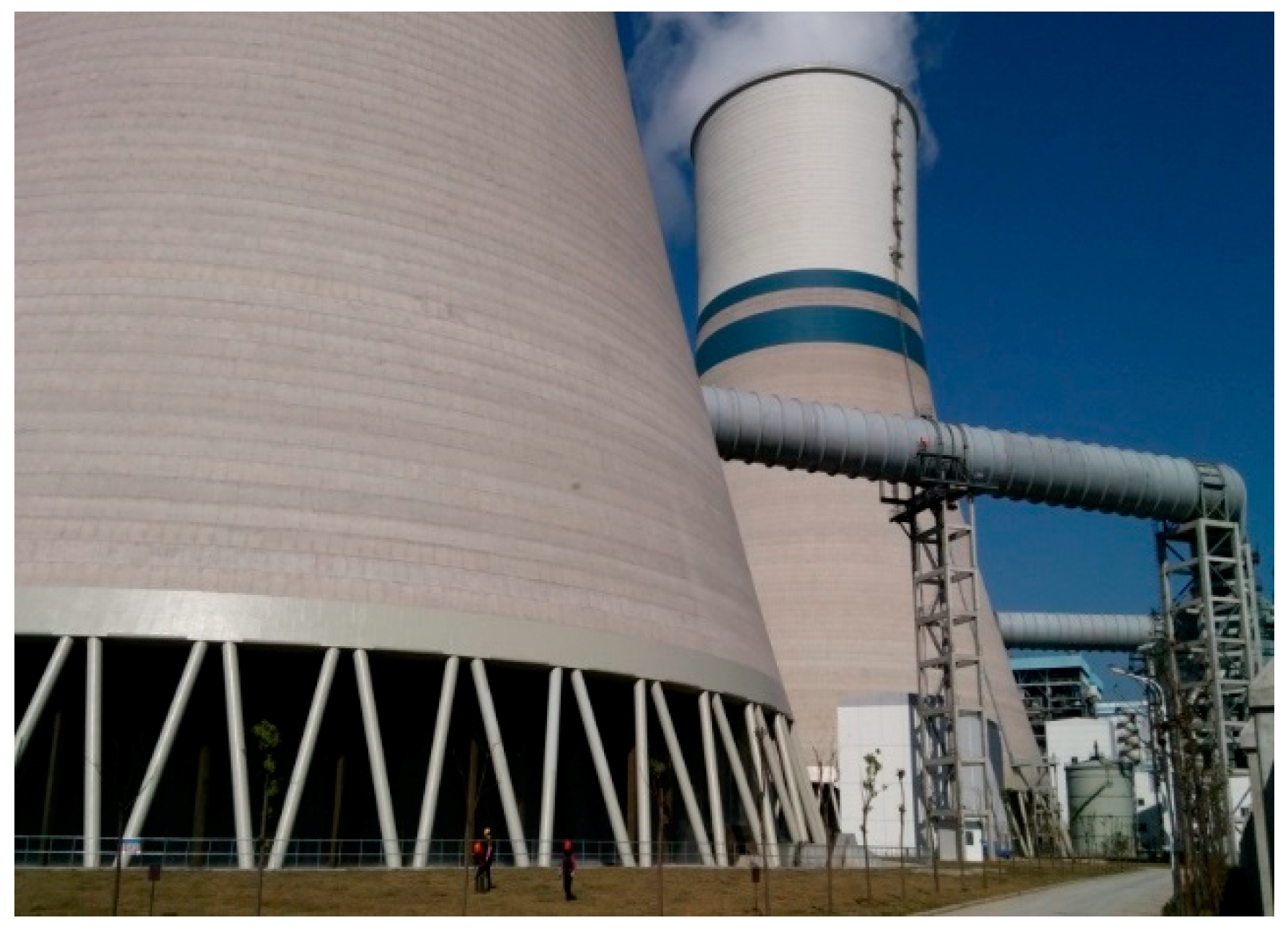
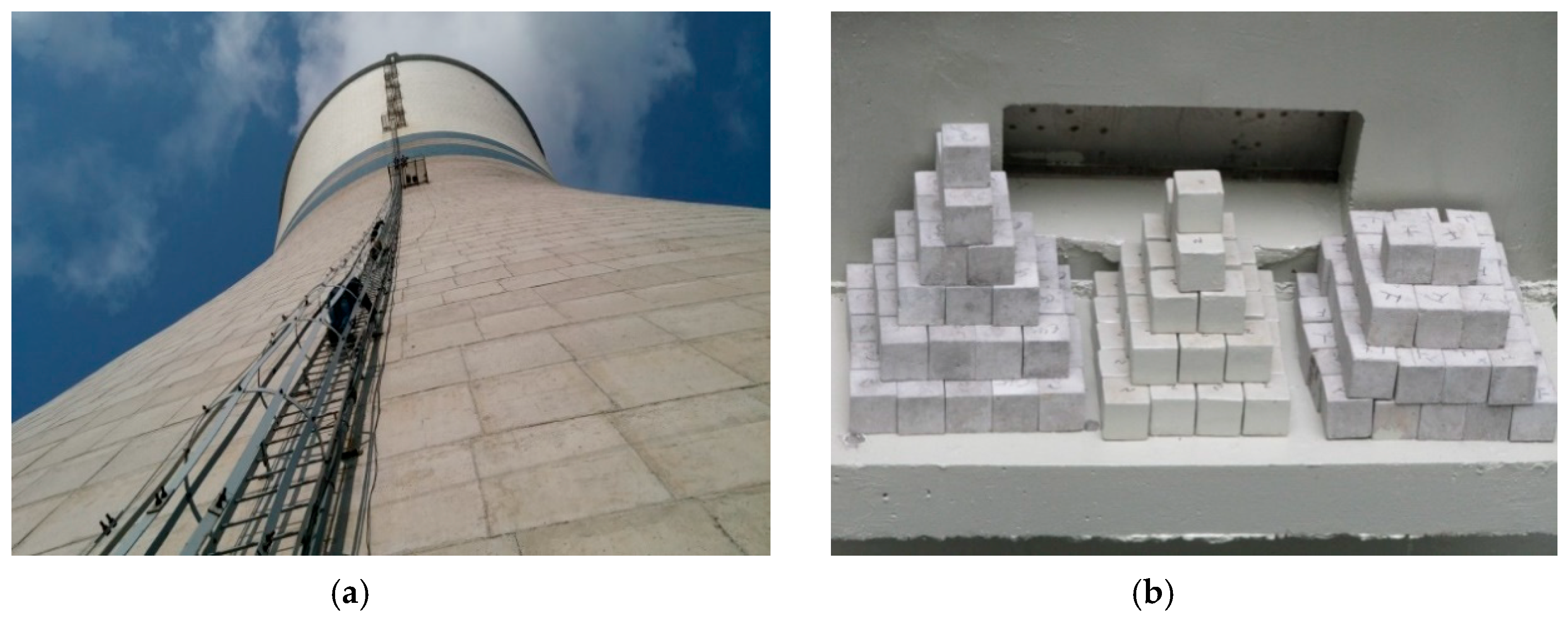
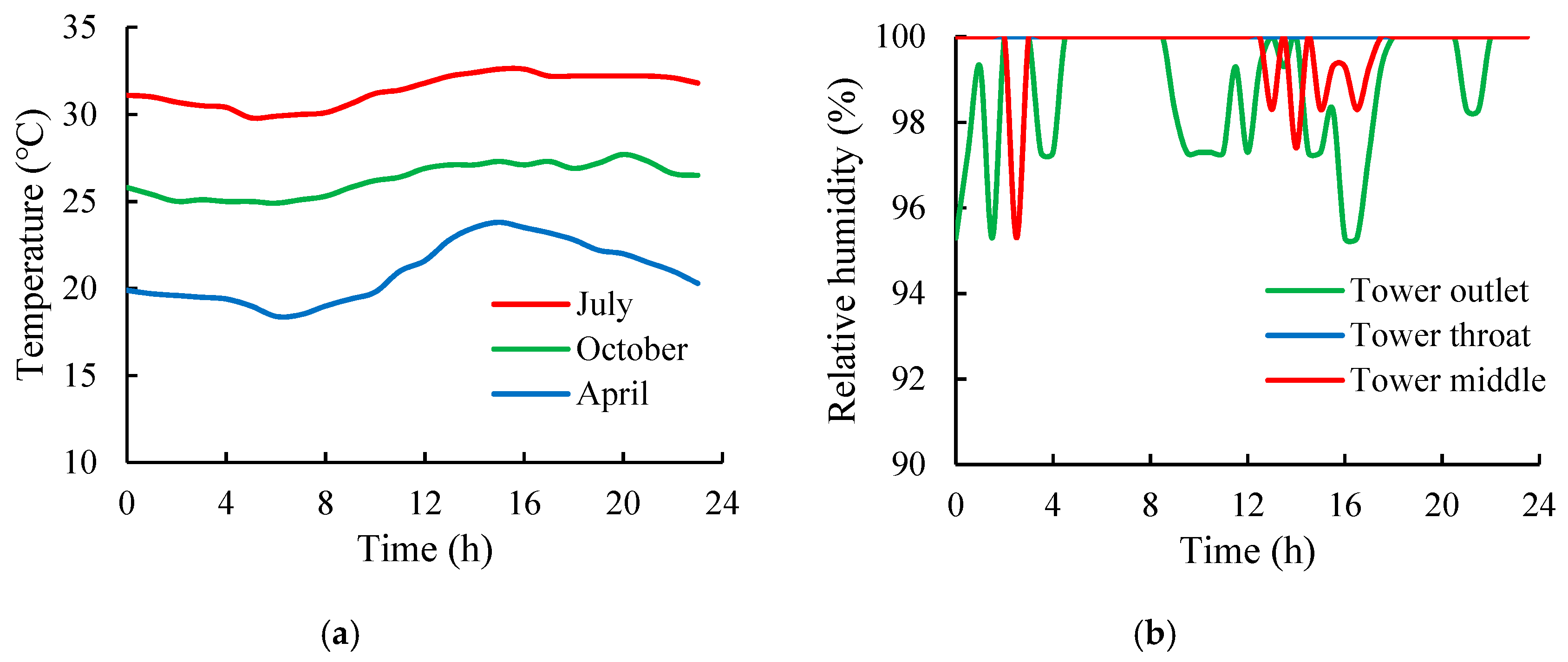
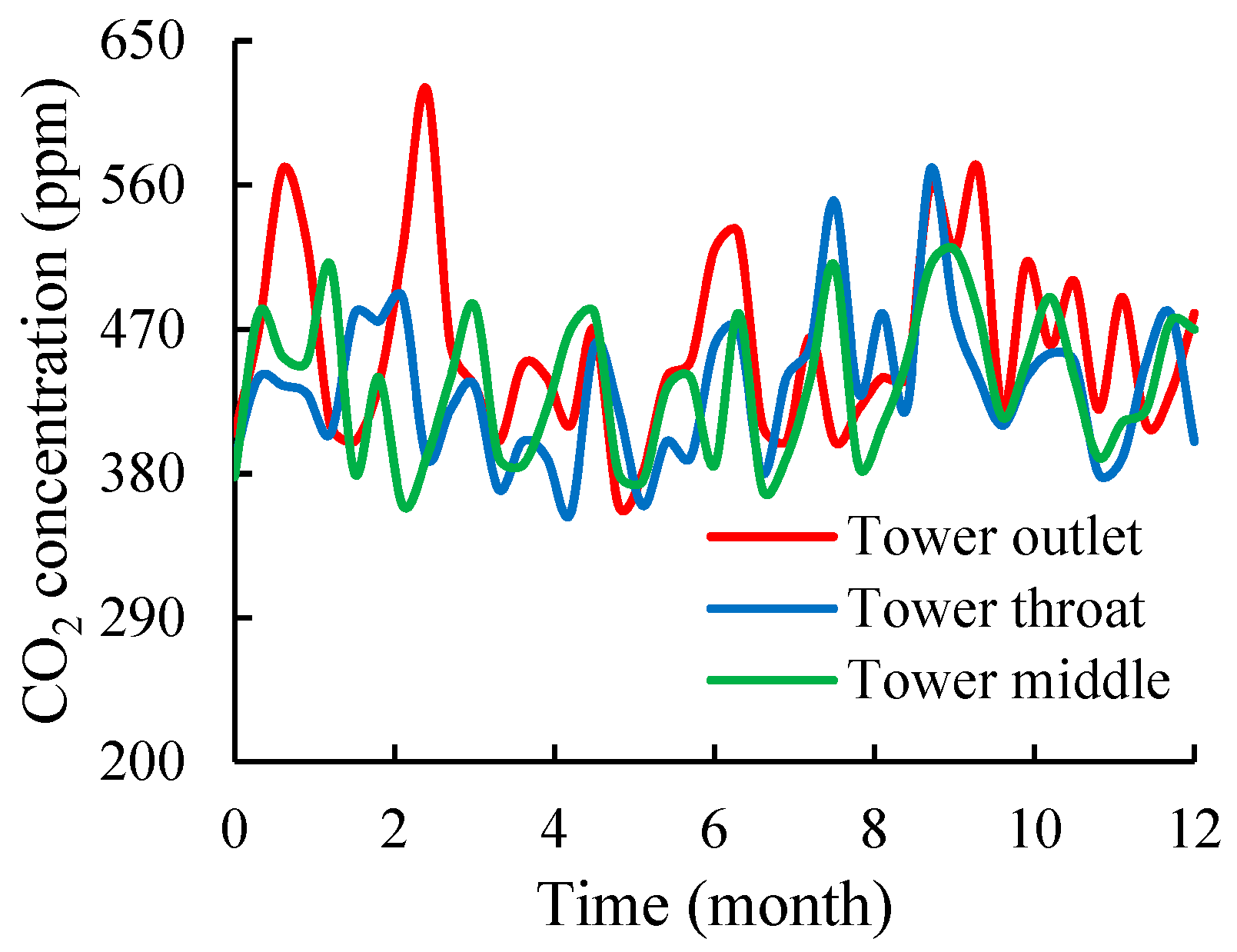


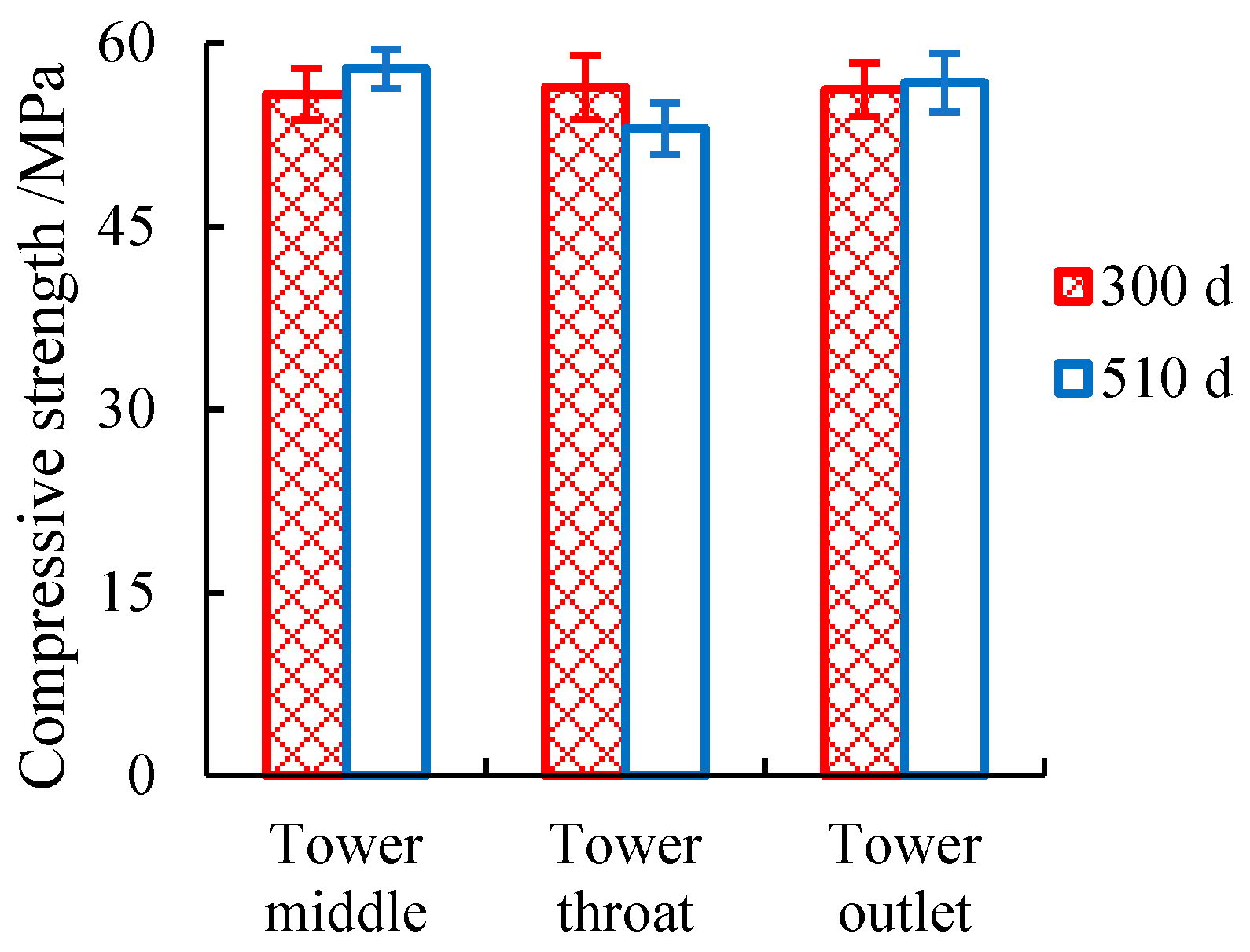



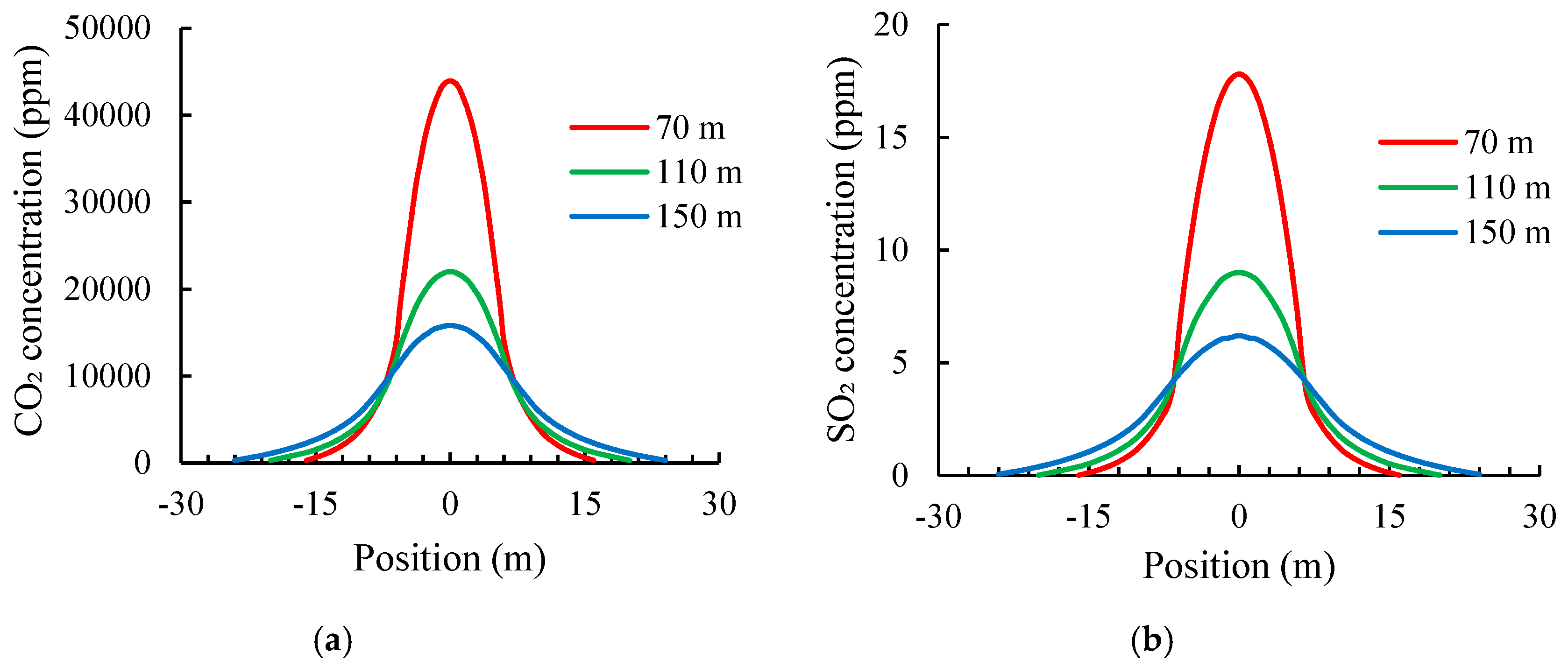

| Cement | Sand | Stone | Water | Water Reducer | Fly Ash | Silica Fume | |
|---|---|---|---|---|---|---|---|
| Dosage | 378.7 | 701.3 | 1046.7 | 180 | 7.6 | 70.7 | 23.6 |
| Item | SiO2 | Fe2O3 | Al2O3 | CaO | MgO | Ignition Loss |
|---|---|---|---|---|---|---|
| Cement | 22.3 | 3.2 | 5.0 | 64.9 | 0.9 | 1.32 |
| Fly ash | 57.2 | 4.5 | 30.3 | 2.5 | 0.6 | 2.65 |
| Silica fume | 96.0 | 0.7 | 0.8 | 0.2 | 0.5 | 2.12 |
| Item | Location | Elevation (m) | Monitoring Contents |
|---|---|---|---|
| 1 | Tower middle | 70 | T, RH, CO2, SO2, condensate, and specimens |
| 2 | Tower throat | 112 | T, RH, CO2, SO2, condensate, and specimens |
| 3 | Tower outlet | 150 | T, RH, CO2, SO2, condensate, and specimens |
| Item | Tower Middle | Tower Throat | Tower Outlet |
|---|---|---|---|
| pH value | 6.45 | 6.06 | 6.16 |
| F− ion | 1.9 | 2.1 | 3.7 |
| Cl− ion | 17.2 | 70.2 | 29.2 |
| SO42− ion | 3.8 | 26.9 | 91.7 |
| NO3− ion | 21.8 | 4.0 | 5.9 |
| Item | CO2 | O2 | N2 | SO2 | H2O |
|---|---|---|---|---|---|
| Volume fraction | 11.76 | 5.64 | 71.22 | 0.0048 | 11.38 |
© 2019 by the authors. Licensee MDPI, Basel, Switzerland. This article is an open access article distributed under the terms and conditions of the Creative Commons Attribution (CC BY) license (http://creativecommons.org/licenses/by/4.0/).
Share and Cite
Du, J.; Zhuang, W.; Li, G.; Zhang, P. Influence of Flue Gas Injection on the Long-Term Durability of a Natural Draft Concrete Cooling Tower. Materials 2019, 12, 2038. https://doi.org/10.3390/ma12132038
Du J, Zhuang W, Li G, Zhang P. Influence of Flue Gas Injection on the Long-Term Durability of a Natural Draft Concrete Cooling Tower. Materials. 2019; 12(13):2038. https://doi.org/10.3390/ma12132038
Chicago/Turabian StyleDu, Jianmin, Wenjuan Zhuang, Guo Li, and Pei Zhang. 2019. "Influence of Flue Gas Injection on the Long-Term Durability of a Natural Draft Concrete Cooling Tower" Materials 12, no. 13: 2038. https://doi.org/10.3390/ma12132038
APA StyleDu, J., Zhuang, W., Li, G., & Zhang, P. (2019). Influence of Flue Gas Injection on the Long-Term Durability of a Natural Draft Concrete Cooling Tower. Materials, 12(13), 2038. https://doi.org/10.3390/ma12132038






